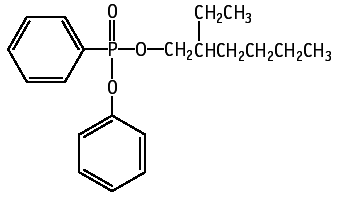

Diphenyl 2-ethylhexyl phosphate was studied for oral toxicity in rats in a 28-day repeat dose toxicity test at doses of 0, 4, 20, 100 and 500 mg/kg.
A decrease in food consumption was observed in the 500 mg/kg group. Hematological examination revealed prolongation of APTT in the 500 mg/kg group. Blood chemical examination revealed decreases in plasma cholinesterase, blood cell cholinesterase, GOT and ALP and increases in total cholesterol, total protein, and albumin in the 100 and/or 500 mg/kg groups. The liver weights were increased and centrilobular hypertrophy of hepatocytes was histologically noted in the 100 and 500 mg/kg groups. An increase in hyaline droplets of proximal renal tubules was observed in males given 500 mg/kg. Hypertrophy of follicular epithelial cells of the thyroid glands was noted in the 100 and 500 mg/kg groups. The adrenal weights were increased in the 100 and 500 mg/kg groups and histopathologically, an increase in the amounts of lipid droplets in the fascicular zone was observed in the 500 mg/kg group. These changes disappeared or demonstrated a tendency for reduction during the recovery period.
The NOEL for the repeat dose toxicity is considered to be 20 mg/kg/day for both sexes.
Diphenyl 2-ethylhexyl phosphate was not mutagenic in Salmonella typhimurium, TA100, TA1535, TA98, TA1537 or Escherichia coli WP2uvrA. Regardless of the presence or absence of exogenous metabolic activation system, this chemical substance did not induce structural chromosomal aberrations in CHL/IU cells. Polyploidy was also not induced under the conditions of the present study.
| Purity | : | 91.4% |
| Test species/strain | : | Rat/Crj:CD (SD) |
| Test method | : | Guidelines for 28-Day Repeat Dose Toxicity Testing for Chemicals (Japan) |
| Route | : | Oral (gavage) |
| Dosage | : | 0 (vehicle), 4, 20, 100, 500 mg/kg/day |
| Number of animals/group | : | Males, 6; females, 6 |
| Vehicle | : | 0.1% Tween 80 solution |
| Administration period | : | Males and females, 28 days |
| Terminal kill | : | Days 29 or 43 |
| GLP | : | Yes |
Test results:
The NOEL for the repeat dose toxicity is considered to be 20 mg/kg/day for both sexes.
| Purity | : | 91.4 % |
| Test species/strain | : | Salmonella typhimurium, TA100, TA1535, TA98, TA1537 Escherichia coli WP2uvrA |
| Test method | : | OECD Guidelines No. 471, 472 and Guidelines for Screening Mutagenicity Testing of Chemicals (Japan) |
| Procedures | : | Pre-incubation method |
| Solvent | : | DMSO |
| Positive controls | : | -S9 mix, AF-2 (TA100, TA98), Sodium azide (TA1535), ENNG (WP2 uvrA) and 9-Aminoacridine (TA1537) +S9 mix, 2-Aminoanthracene(all strains) |
| Doses | : | -S9 mix; 313, 625, 1250, 2500, 5000 μg/plate +S9 mix; 313, 625, 1250, 2500, 5000 μg/plate |
| S-9 | : | Rat liver, induced with phenobarbital and 5,6-benzoflavone |
| Plate/test | : | 3 |
| Number of replicates | : | 2 |
| GLP | : | Yes |
Test results:
Genotoxic effects:
S. typhimurium, TA100, TA1535, TA98, TA1537
| + | ? | - | |
| Without metabolic activation: | [ ] | [ ] | [*] |
| With metabolic activation: | [ ] | [ ] | [*] |
E. coli WP2 uvrA
| + | ? | - | |
| Without metabolic activation: | [ ] | [ ] | [*] |
| With metabolic activation: | [ ] | [ ] | [*] |
| Purity | : | 91.4 % |
| Type of cell used | : | Chinese hamster CHL/IU cells |
| Test method | : | OECD Guidelines No. 473 and Guidelines for Screening Mutagenicity Testing of Chemicals (Japan) |
| Solvent | : | acetone |
| Positive controls | : | -S9 mix, Mitomycin C +S9 mix, Benzo[a]pyrene |
| Doses | : | -S9 mix (24 hr continuous treatment): 0, 6.25, 12.5, 25, 50 μg/ml -S9 mix (48 hr continuous treatment): 0, 3.13, 6.25, 12.5, 25 μg/ml -S9 mix (6 hr short-term treatment): 0, 10, 20, 40, 80 μg/ml +S9 mix (6 hr short-term treatment): 0, 25, 50, 100, 200 μg/ml |
| S-9 | : | Rat liver, induced with phenobarbital and 5,6-benzoflavone |
| Plate/test | : | 2 |
| GLP | : | Yes |
Test results:
Genotoxic effects:
| clastogenicity | polyploidy | |||||
| + | ? | - | + | ? | - | |
| Without metabolic activation: | [ ] | [ ] | [*] | [ ] | [ ] | [*] |
| With metabolic activation: | [ ] | [ ] | [*] | [ ] | [ ] | [*] |
| 1) | The tests were performed by the Mitsubishi Chemical Safety Institute Ltd., 14 Sunayama, Hasaki-machi, Kashima-gun, Ibaraki, 314-02, Japan. Tel +81-479-46-2871 Fax +81-479-46-2874 |